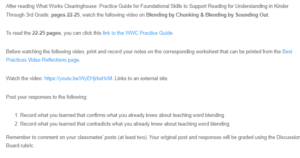Best Practices Video Reflection – Blending by Chunking and Blending by Sounding Out
All the concepts depicted by the video confirm prior knowledge and strategies incorporated in word blending activities. According to Foorman et al. (2016), “blending is the process of reading a word systematically from left to right by combining successive letters into one sound.” The video confirms the definition learned earlier on word blending. The video further concurs with skills acquired in blending words. There are two strategies for blending words. Either by chunking sounds or sounding out each letter individually and altering the sound made by each letter before saying the word that the letters create (REL Program, 2016).
Chunking involves reading the sounds in a word from left to right by combining each sound with the previous altered sound before proceeding to the next sound (Foorman et al., 2016, p. 23). As illustrated in the video example, the word ‘hat’ is blended through the chucking process as /h/, then /a/, and the two sounds are first blended as /ha/ before reading the /t/ and blending it to /ha/ to form /hat/. On the other hand, sounding out involves altering all sounds for a word individually and then reading through the sounds quickly. For instance, the sounding out of the word ‘hat’ is /h/ /a/ /t/ to form the word ‘hat’ (REL Program, 2016).
The video does not contain contradictory information on integrating blending concepts. The information in the video aligns with the prior knowledge of the different ways of blending words. Teachers should guide the students through the blending activity, starting with simple words with consonant-vowel-consonant patterns (Foorman et al., 2016, p. 23). The teacher should give multiple examples before giving the students examples to work on independently. The teacher should provide constructive feedback to students as they work on assigned tasks before proceeding to longer words.
References
Foorman, B., Beyler, N., Borradaile, K., Coyne, M., Denton, C. A., Dimino, J., … & Wissel, S. (2016). Foundational Skills to Support Reading for Understanding in Kindergarten through 3rd Grade. Educator’s Practice Guide. NCEE 2016-4008. What Works Clearinghouse.
REL Program. (Director). (2016). Video 21: Blending by chunking; blending by sounding out [Motion Picture]. Retrieved from https://www.youtube.com/watch?v=WyEHjrbxHcM
ORDER A PLAGIARISM-FREE PAPER HERE
We’ll write everything from scratch
Question 

Blending by Chunking and Blending by Sounding Out
After reading What Works Clearinghouse: Practice Guide for Foundational Skills to Support Reading for Understanding in Kinder Through 3rd Grade, pages 22-25, watch the following video on Blending by Chunking & Blending by Sounding Out.
To read the 22-25 pages, you can click this link to the WWC Practice Guide.
Before watching the following video, print and record your notes on the corresponding worksheet that can be printed from the Best Practices Video Reflections page.
Watch the video: https://youtu.be/WyEHjrbxHcM. Links to an external site.
Post your responses to the following:
- Record what you learned that confirms what you already knew about teaching word blending.
- Record what you learned that contradicts what you already knew about teaching word blending.
Remember to comment on your classmates’ posts (at least two). Your original post and responses will be graded using the Discussion Board rubric.
